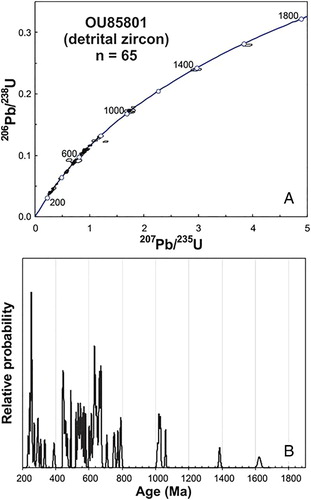ABSTRACT
Metamorphosed felsic volcanic rocks occur interlayered with metasedimentary schist in close association with a 7 km long metabasaltic (greenschist) horizon in the Otago Schist belt of Central Otago. The felsic metavolcanic rocks are weakly foliated and locally segregated and consist principally of quartz and albite. Geochemical analyses suggest phonolitic compositions and a general within-plate affinity for the felsic metavolcanics rocks, and a MORB/back arc basalt affinity for the associated metabasalts. Zircons from two felsic metavolcanic samples are stubby, sharply faceted, prismatic grains with no visible inherited cores, and are considered to be of primary magmatic origin. Calculated weighted average 206Pb–238U ages for zircons from the two felsic metavolcanic samples are 190.5 ± 0.6 Ma and 190.1 ± 0.3 Ma. We interpret these ages (late Aratauran–early Ururoan; middle Early Jurassic) to date the deposition of the Torlesse Terrane metasediments at that locality, and also possibly the emplacement of the associated metabasalts.
Introduction
Metavolcanic rocks comprise a volumetrically minor but widespread component of the mainly metasedimentary Torlesse Terrane in the South Island of New Zealand. These rocks are typically mafic in composition, and at low metamorphic grade have preserved basaltic features such as pillow structures and porphyritic textures (Pringle Citation1980). The bodies are irregular and podiform, and although contacts with the hosting metasediments are locally sheared, they commonly appear to be depositional (Pringle Citation1980). At higher metamorphic grades, up to greenschist facies, the metavolcanic rocks have been pervasively recrystallised and are generally well foliated with little preservation of primary features. These metavolcanic bodies, usually termed greenschists, are typically elongate parallel to the enclosing foliation, and many can be traced along strike for several kilometres (Turnbull Citation2001; Bierlein and Craw Citation2009).
Greenschist layers are mineralogically variable internally, on the scale of centimetres to metres, but are dominated by albite, chlorite, actinolite and epidote in varying proportions (Craw Citation1984; Bierlein and Craw Citation2009). In this study, we describe an unusual felsic rock type in Central Otago previously unreported in the literature, that is spatially associated with a greenschist layer. This felsic rock is interpreted to have a volcanic protolith (see later discussion); however, its genetic relationship to the adjacent greenschist unit is uncertain. The felsic metavolcanic rock has been metamorphosed along with the greenschist and the adjacent quartzofeldspathic metasedimentary schist. The field relationships and original textures, although obscured by deformation and metamorphism, suggest that the felsic volcanic rock may have had a tuffaceous protolith. If correct, this felsic unit provides an opportunity to further unravel the geological history of the enclosing schist, by providing new information on the compositional range and tectonic affinities of the metavolcanic layers in the Torlesse Terrane, as described herein. Further, we report results of U–Pb dating of zircons separated from the felsic metavolcanic unit, which are interpreted to be of primary magmatic origin. Hence, we report here the first crystallization age for formation of rocks within the schistose Torlesse Terrane of Central Otago, which we interpret to be a depositional age. We then evaluate these results in the context of the geological evolution of the Torlesse Terrane.
General setting
The Torlesse Terrane consists mainly of quartzofeldspathic metagreywackes and meta-argillites which range in age from Early Permian to middle Cretaceous (Mackinnon Citation1983; Mortimer Citation2004). The internal structure is complex, reflecting the origin of the terrane as an accretionary complex along the margin of Gondwana (Mortimer Citation2004). The terrane was variably metamorphosed and uplifted in the Jurassic and Cretaceous, with the highest metamorphic grades exposed as the Otago Schist belt (; Mortimer Citation1993, Citation2000). The Otago Schist has a core of pervasively recrystallised upper greenschist facies Torlesse Terrane schists, which contain minor biotite and garnet (Mortimer Citation2000). There is a regional metamorphic and structural transition from these high grade rocks to prehnite–pumpellyite facies rocks, in which bedding and fossils can be recognised (Mackinnon Citation1983; Mortimer Citation1993, Citation2000). This transition has been extensively disrupted, and most metamorphic boundaries now occur at faults (Mortimer Citation2000; MacKenzie and Craw Citation2005; Henne et al. Citation2011).
Figure 1. Location maps. A, Location of Otago Schist belt in South Island of New Zealand. B , Geological map of the Otago Schist belt, showing North Rough Ridge area () within upper greenschist facies (Textural Zone 4) Torlesse Terrane schists.
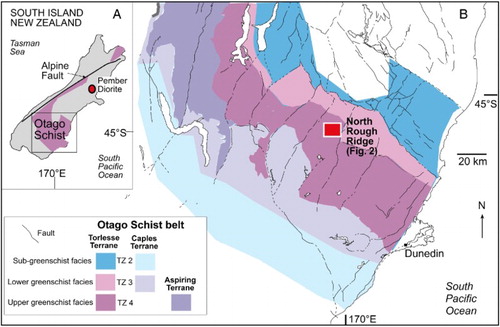
Figure 2. Geological map of a portion of North Rough Ridge, showing principal greenschist horizons and associated felsic metavolcanic rock localities. Grid is NZTM 2000.
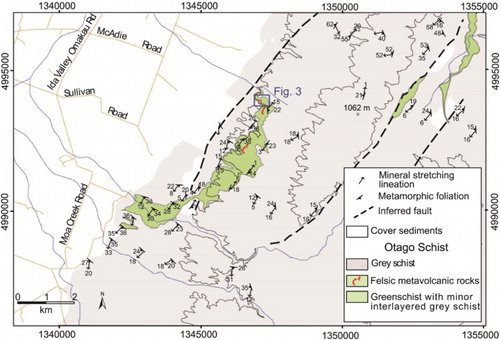
The felsic metavolcanic rocks of interest in this study occur in the highest grade core of the Otago Schist belt, on North Rough Ridge (B). On a regional scale, the ridge has a broad antiformal structure of folded flat-lying schist foliation, although zones of steeper foliation occur as well (; MacKenzie and Craw Citation2005). The antiform was initiated in the Pleistocene, as part of a regionally extensive set of folds that dominate Central Otago (Bennett et al. Citation2005). Uplift of the ridge, which is ongoing, has exposed the schist basement after erosion of overlying Miocene and Pliocene sediments (Bennett et al. Citation2005).
Felsic metavolcanic localities on North Rough Ridge () were originally identified by Coote et al. (Citation2011). These units occur in close association with a distinctive greenschist layer that is traceable for 7 km on the flanks of the ridge (; MacKenzie and Craw Citation2005). Several felsic metavolcanic bodies have been identified along this greenschist layer (). Another thinner greenschist unit has been mapped farther to the northeast (), and airborne magnetic surveys (Martin et al. Citation2014) suggest that these bodies are likely much more extensive in the subsurface. However, no other occurrences of felsic metavolcanic rocks associated with these greenschists have been identified thus far.
Methods
Mapping of the greenschist horizons on North Rough Ridge was conducted by MacKenzie and Craw (Citation2005) and as part of a regional prospecting project by Glass Earth Gold Ltd. One locality at the northernmost end of the greenschist layer was sampled for this study (). Samples were collected from both the felsic metavolcanic rocks () and the nearby greenschist for petrographic and geochemical characterisation, and for U–Pb zircon dating. In addition, a sample of quartzofeldspathic metagreywacke that encloses the felsic metavolcanic and greenschist layers was collected for extraction and dating of detrital zircons. Major, trace and rare earth element (REE) analyses were completed for two samples of the felsic metavolcanic rocks and one sample of greenschist from the North Rough Ridge locality. Analyses were done at the ALS Chemex laboratory in North Vancouver, Canada, using inductively coupled plasma (ICP) atomic emission (ICP-AES) and mass spectrometry (ICP-MS) methods for major and trace/REE analyses, respectively.
Figure 3. Felsic schist horizon that is interlayered with greenschist and minor metagreywacke on North Rough Ridge in the vicinity of NZTM 2000 E1347177, N993518. A, General view of outcrop of felsic schist. B , Close view of outcrop of felsic schist. C , Thin section view (transmitted light, crossed polars) of the felsic schist (OU 85799) from outcrop in (A). D , Thin section view of the felsic schist (OU 85797) from outcrop in (A). Dark areas in (B) are lichen.
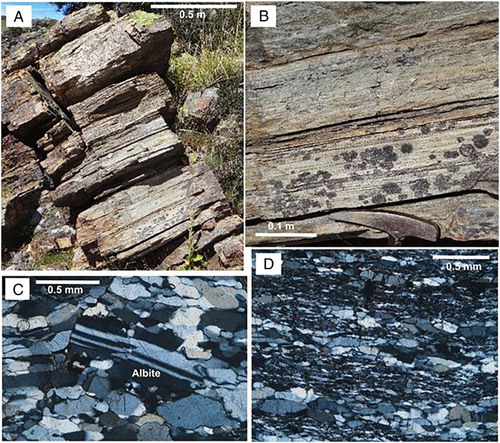
Two samples of felsic metavolcanic rock, each weighing c. 5 kg, were collected from separate surface outcrops for U–Pb zircon dating. Zircons were separated from each using conventional crushing, grinding, Wilfley table, heavy liquids and Frantz magnetic separator techniques. Isotopic analyses were done by laser ablation (LA) ICP-MS methods at the Pacific Centre for Isotopic and Geochemical Research (PCIGR) at the University of British Columbia. The methodology for zircon selection, mounting, and analysis for the U–Pb age determinations by laser ablation ICP-MS, are described by Tafti et al. (Citation2014) and Beranek and Mortensen (Citation2011). A spot size of c. 35 μm was used, and line scans rather than spot analyses were utilised to minimise the extent of within-run elemental fractionation. A metagreywacke sample was processed and analysed in the same way for determination of ages of detrital zircons.
Field characteristics and petrography
The felsic metavolcanic units form blocky, fine grained, laminated outcrops with a well-defined planar foliation (A,B). The felsic metavolcanic shown in outcrop in (A) is c. 4 m thick, and has grey quartzofeldspathic schist structurally above and below the felsic layer. The boundaries between the felsic metavolcanics and enclosing schist are diffuse, partly because of the foliation overprint, and are poorly exposed, but occur over < 30 cm. The felsic metavolcanic is only weakly segregated (B), in contrast to the adjacent quartzofeldspathic schist which has irregular micaceous foliation anastomosing around numerous lenses of quartz–albite metamorphic segregations and veins. The felsic metavolcanic units are conformable with the layering (at least some of which is depositional) in the host metagreywackes; however, we cannot preclude the possibility that the felsic units may have been emplaced discordant to layering in the metagreywackes and subsequently transposed into parallelism with that layering during deformation and metamorphism.
At the microscopic scale, the abundant albite and quartz that make up the felsic metavolcanic are commonly medium-grained (100–200 µm) with coarser and finer grained laminae (C,D). Near-planar quartz and albite laminations show up grain size variations on the 200 µm scale (C,D). Subordinate fine-grained muscovite (<200 µm) enhances the foliation, especially in the finer grained laminae (D). Most albite has been completely recrystallized and is untwinned, with grains elongated parallel to the foliation and intergrown with the quartz (C). Rare, relatively coarse-grained (up to 1 mm) twinned albite grains occur in some coarser grained laminae, and may represent relict primary igneous crystals (c.f. Craw and Angus Citation1993).
Igneous geochemistry
Geochemical analyses for two samples of felsic metavolcanic and one sample of massive greenschist from the Rough Ridge locality are presented in , and are plotted together with available analyses of greenschists from elsewhere in the Otago Schist belt in . Major element compositional plots (Le Bas et al. Citation1986; A) suggest a trachytic composition for two samples of the felsic metavolcanic and a basaltic composition for the greenschist. In light of the high degree of strain and metamorphic recrystallization that the units have suffered, however, it is probable that at least some amount of major element mobility has affected the rock units. A plot of immobile element ratios (Zr–TiO2 versus Nb–Y; Winchester and Floyd Citation1977; B) confirms the basaltic composition of the greenschist, as well as the relatively alkaline affinity of the felsic metavolcanic rocks, which plot in the phonolite field. The greenschist sample plots with most other Torlesse Terrane greenschists in the mid-ocean ridge basalt/back arc basalt field on a Shervais (Citation1982) plot of V versus Ti/1000, and shows slight light REE enrichment and no discernible Eu anomaly on a plot of REE/primitive mantle (D). In contrast, the two felsic metavolcanic samples show stronger light REE enrichment and a pronounced negative Eu anomaly when plotted against primitive mantle (D), indicating that substantial plagioclase fractionation likely affected the parent magma prior to eruption.
Figure 4. Geochemistry of North Rough Ridge felsic metavolcanic rocks (
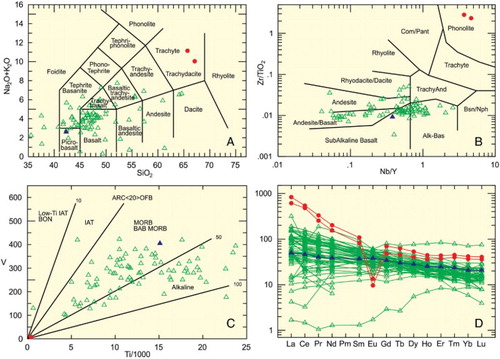
Table 1. Geochemical analyses of felsic metavolcanic rocks and greenschist from North Rough Ridge.
U–Pb geochronology
Abundant zircons recovered from each of the two felsic metavolcanic samples consisted of stubby, sharply faceted, square prismatic grains with no visible inherited cores. Cathodoluminescence imaging of the zircons show weak concentric zonation typical of igneous zircons (). Twenty-six zircon grains were analysed from sample OU85797 and all fall on or very near to concordia (; A). A calculated weighted average of the 206Pb–238U ages for 20 of the concordant analyses gives an age of 190.5 ± 0.6 Ma; however, there is some scatter in the data, resulting in a calculated mean square weighted deviation (MSWD) of 2.5 and a probability of fit = 0.0 (B). Six of the grains yielded slightly older ages, ranging from 204 to 195 Ma, and are interpreted to have been xenocrysts. A total of 30 zircon grains were analysed from the second sample (OU85799), and all but one of the analyses were concordant (C). Twenty-six of the concordant analyses give a weighted average 206Pb–238U age of 190.1 ± 0.3 Ma, with a MSWD = 1.01 and a probability of fit of 0.44 (D). This is interpreted as the crystallization age for the sample and is in good agreement with that determined for the previous sample. Two grains from this sample gave older ages of 206 and 197 Ma, and are interpreted to have been xenocrysts. One grain gave a slightly younger age, reflecting the effects of minor post-crystallization Pb loss.
Figure 5. U–Pb concordia and weighted average 206Pb/238U plot for zircons from North Rough Ridge felsic metavolcanic samples. Error ellipses and error boxes show errors at a 2σ level. Errors on calculated ages are also at a 2σ level. Analyses shown as blue boxes in B and D were excluded from the weighted average age calculations. Cathodoluminescence images of representative zircon grains from each sample are also shown. Laser ablation tracks on the zircon images (white dashed outlines) are c. 120 μm long.

Table 2. U–Pb LA-ICP-MS analytical data for zircons from North Rough Ridge felsic metavolcanic rocks.
Detrital zircons were separated from a sample of metagreywacke (sample OU85801) that is structurally beneath the felsic metavolcanic and U–Pb ages for a total of 65 grains were determined using LA-ICP-MS methods. Because the goal of this part of the study was to attempt to provide a maximum possible depositional age for the sample, euhedral zircons that had a higher probability of being first-cycle were preferentially selected for analysis. Analytical data are listed in Table S1 and are shown on a conventional concordia plot and a cumulative probability plot in (A) and (B), respectively. Despite the sampling bias imposed by preferentially selecting only euhedral igneous zircons, the range of ages obtained from the sample is very similar to those reported from many other samples of Torlesse Terrane metaclastic rocks (Adams et al. Citation2007). There is a cluster of eight zircon grains with concordant ages of 258–236 Ma (). However, the youngest zircon age that was obtained is 236 ± 3 Ma (latest Middle Triassic), providing a maximum depositional age for the unit.
Discussion
The regional distribution of greenschists within the Otago Schist belt has been well documented both from surface mapping and airborne geophysical studies, and a substantial body of lithogeochemical data has been generated for many of these units. The North Rough Ridge locality is the only area recognised to date where there is evidence for spatially closely associated mafic and felsic magmatism within the Otago Schist belt. Although the greenschist bodies are compositionally clearly distinct from the enclosing quartzofeldspathic metasediments, the difference in appearance between the felsic metavolcanic and the host metasediments in the field is more subtle. As indicated in , we have identified several other occurrences of possible felsic metavolcanic in the North Rough Ridge area, and it is very possible that numerous other felsic metavolcanic localities have gone unrecognised, or been mapped as metacherts, outside of our immediate study area.
The difficulty in determining absolute depositional ages for both the metasedimentary rocks and the greenschists in the Torlesse Terrane has greatly hindered development of a comprehensive model for evolution of the terrane. Fossils are scarce in the metasedimentary units, especially in the higher grade and more strongly deformed portions, and to date no material amenable to precise and accurate isotopic dating methods had been identified. Detrital zircon ages from the metasediments provide maximum depositional ages (which cannot be older than the youngest concordant zircon age). Recent studies by Cooper and Ireland (Citation2013) and Jugum et al. (Citation2013) have demonstrated that protolith ages for significant portions of the schist belt are considerably younger than had originally been thought. We tentatively interpret the felsic metavolcanic rocks in the North Rock Ridge area to have had a tuffaceous protolith. The felsic metavolcanics are closely spatially associated with the greenschists, and original contact relationships are not completely clear; hence, we cannot be certain whether the felsic metavolcanics were originally concordant with primary layering in the enclosing metasediments or were in part discordant to layering and have been transposed into parallelism with it. The fine-grained character of the rock supports, but does not prove that it had an extrusive origin, or at least a very high-level of emplacement. Compositionally the felsic metavolcanic rocks yield a within-plate tectonic signature, which differs from the mid-ocean ridge basalt/back arc basalt signature of the greenschists, and suggests that the felsic and mafic rock units are not directly cogenetic. We interpret our U–Pb zircon age of 190–191 Ma (late Aratauran–early Ururoan; middle Early Jurassic) for the felsic metavolcanic rocks at North Rough Ridge to date the deposition of the metagreywackes at that locality, and also possibly the emplacement of the associated greenschists (metabasalts).
Jongens et al. (Citation2009) describe a number of mafic dikes and small stocks of microdiorite in the vicinity of Mt. Pember, c. 70 km northwest of Christchurch (A). These bodies cut low-grade sandstones of the Rakaia Terrane, which have locally given Late Triassic fossil ages. The intrusive rocks are generally massive and unfoliated. However, petrographic studies indicate that they have experienced prehnite–pumpellyite facies metamorphism along with the enclosing clastic rocks. Geochemical analyses of two samples of microdiorite (included in ) indicate intermediate compositions and within-plate or back-arc basin signatures (Jongens et al. Citation2009), with some influence from subduction-related processes (possibly through crustal contamination of the magmas). An 40Ar–39Ar crystallization age of 185.6 ± 3.3 Ma was obtained for hornblende from one of the diorite bodies (Jongens et al. Citation2009). This age is only slightly younger than the U–Pb zircon ages that we determined for the North Rough Ridge felsic metavolcanic rocks. Although the intrusions in the Mt. Pember area have not experienced the same high degree of strain as the felsic metavolcanic rocks, they show the same relative age with respect to regional deformation and metamorphism, and we speculate that the diorites (and associated mafic dikes) at Mt. Pember, the felsic metavolcanic rocks and at least some of the greenschists may be broadly comagmatic and result from the same general tectonic processes.
The new U–Pb zircon age results reported here provide the first direct evidence for the age(s) of greenschists in the Otago Schist belt. The regional significance of these data is uncertain as yet, although the possible correlation with nearly coeval intrusive rocks in low grade Torlesse Terrane (Pember Diorite; A) suggest that the middle Early Jurassic magmatic event might have been regional in extent.
Conclusions
We present middle Early Jurassic (191–190 Ma) U–Pb zircon crystallization ages for two samples of felsic metavolcanic rock from the North Rough Ridge area of Central Otago. We interpret these units to have been derived from a tuffaceous protolith; hence their age also provides the first direct depositional age for the metagreywackes of the Torlesse Terrane in this part of South Island. The felsic metavolcanic rocks yield phonolitic compositions with a within-plate tectonic affinity. Greenschists that are spatially closely associated with the felsic metavolcanics at North Rough Ridge are basaltic in composition and have a mid-ocean ridge or back-arc basin basalt petrotectonic affinity. Despite the close spatial association of the felsic metavolcanics and greenschists, it is still uncertain what the original relationship, if any, was between these rock units. We speculate that mafic to intermediate intrusive rocks from the Torlesse Terrane northwest of Christchurch (the Pember Diorite of Jongens et al. Citation2009), which has been dated at 185.6 Ma, may also be part of a previously unrecognised regionally developed Early Jurassic magmatic event in the Torlesse Terrane. Many other felsic metavolcanic rock units may be present within the Torlesse Terrane but have not been recognised or have been mapped as metacherts.
Supplementary Table 1. Laser ablation ICP-MS U-Pb zircon ages for detrital zircons from sample OU85801.
Download MS Excel (340 KB)Acknowledgments
We thank the staff of the Pacific Centre for Isotopic and Geochemical Research at the University of British Columbia for assistance in producing the U–Pb analyses reported here. This research was funded by a Discovery Grant from the Natural Sciences and Engineering Research Council of Canada to J. K. Mortensen. Additional support was provided from a research subcontract from NZ Ministry for Business Innovation and Employment. We thank Glass Earth Gold Ltd. for logistical support for the field work. The manuscript was improved by critical reviews by Adam Martin, Rodney Grapes, and Associate Editor Timothy Little.
Disclosure statement
No potential conflict of interest was reported by the authors.
References
- Adams CJ, Campbell HJ, Griffin WL. 2007. Provenance comparisons of Permian to Jurassic tectonostratigraphic terranes in New Zealand: perspectives from detrital zircon age patterns. Geological Magazine. 144:701–729. doi: 10.1017/S0016756807003469
- Barber A, Craw D. 2002. Lithology, geochemistry, and structure of Moke Creek sulphide deposit host rocks, Otago Schist, New Zealand. New Zealand Journal of Geology & Geophysics. 45:193–205. doi: 10.1080/00288306.2002.9514968
- Bennett ER, Youngson JH, Jackson JA, Norris RJ, Raisbeck GM, Yiou F, Fielding E. 2005. Growth of south Rough Ridge, Central Otago, New Zealand: using in situ cosmogenic isotopes and geomorphology to study an active blind reverse fault. Journal of Geophysical Research: Solid Earth. 110:21. B020404. doi:10.1029/2004JB003184.
- Beranek LP, Mortensen JK. 2011. The timing and provenance record of the Late Permian Klondike orogeny in northwestern Canada and arc-continent collision along western North America. Tectonics. 30: TC5017, 23p. doi: 10.1029/2010TC002849
- Bierlein FP, Craw D. 2009. Petrogenetic character and provenance of metabasalts in the Aspiring and Torlesse terranes, South Island, New Zealand: implications for the gold endowment of the Otago Schist?. Chemical Geology. 260:301–315. doi: 10.1016/j.chemgeo.2009.01.016
- Cooper AF, Ireland TR. 2013. Cretaceous sedimentation and metamorphism of the western Alpine Schist protoliths associated with the Pounamu Ultramafic belt, Westland, New Zealand. New Zealand Journal of Geology & Geophysics. 56:188–199. doi: 10.1080/00288306.2013.809776
- Coote JA, Henderson S, Waterhouse I. 2011. Mafic volcanic protoliths of the Otago Schist as a source of hydrothermal gold: consideration of field and petrologic observations. AusIMM New Zealand branch 2011 annual conference; Aug. 27–30, 2011; Queenstown. 55–61.
- Craw D. 1984. Lithologic variations in Otago Schist, Mt Aspiring area, northwest Otago, New Zealand. New Zealand Journal of Geology and Geophysics. 27:151–166. doi: 10.1080/00288306.1984.10422524
- Craw D, Angus PV. 1993. Mafic/ultramafic clasts in deformed biotite zone metaconglomerate, Macraes mine, Haast Schist, New Zealand. New Zealand Journal of Geology & Geophysics. 36:395–398. doi: 10.1080/00288306.1993.9514584
- Fagereng A, Cooper A. 2010. Petrology of metabasalts from the Chrystalls Beach accretionary mélange - implications for tectonic setting and terrane origin. New Zealand Journal of Geology & Geophysics. 53:57–70. doi: 10.1080/00288301003631806
- Henne A, Craw D, MacKenzie D. 2011. Structure of the Blue Lake fault zone, Otago Schist, New Zealand. New Zealand Journal of Geology and Geophysics. 54:311–328. doi: 10.1080/00288306.2011.577080
- Jongens R, Tulloch AJ, Spell TL, Rattenbury MS, Begg JG, Smith Lyttle B. 2009. Pember diorite—an Early Jurassic intrusion in the Rakaia terrane, Puketeraki Range, Canterbury, New Zealand. New Zealand Journal of Geology & Geophysics. 52:37–42. doi: 10.1080/00288300909509876
- Jugum D, Norris RH, Palin JM. 2013. Late Jurassic detrital zircons from the Haast Schist and their implications for New Zealand terrane assembly and metamorphism. New Zealand Journal of Geology & Geophysics. 56:223–228. doi: 10.1080/00288306.2013.815639
- Le Bas MJ, Le Maitre RW, Streckeisen A, Zanettin B. 1986. A chemical classification of volcanic rocks based on the total alkali-silica diagram. Journal of Petrology. 27:745–750. doi: 10.1093/petrology/27.3.745
- MacKenzie DJ, Craw D. 2005. Structural and lithological continuity and discontinuity in the Otago Schist, Central Otago, New Zealand. New Zealand Journal of Geology and Geophysics. 48:279–293. doi: 10.1080/00288306.2005.9515115
- MacKinnon TC. 1983. Origin of the Torlesse terrane and coeval rocks, South Island, New Zealand. Geological Society of America Bulletin. 94:967–985. doi: 10.1130/0016-7606(1983)94<967:OOTTTA>2.0.CO;2
- Martin AP, Mortimer N, Cox SC. 2014. Application of airborne and field geophysics to redefine geology of Otago schist. AusIMM New Zealand branch 2014 annual conference; Aug. 24–27; Hamilton. 353–361.
- Mortimer N. 1993. Jurassic tectonic history of the Otago schist, New Zealand. Tectonics. 12:237–244. doi: 10.1029/92TC01563
- Mortimer N. 2000. Metamorphic discontinuities in orogenic belts: example of the garnet-biotite-albite zone in the Otago schist, New Zealand. Geologische Rundschau/ International Journal of Earth Sciences. 89:295–306. doi: 10.1007/s005310000086
- Mortimer N. 2004. New Zealand’s geological foundations. Gondwana Research. 7:261–272.
- Pitcairn IK, Craw D, Teagle DAH. 2015. Metabasalts as sources of metals in orogenic gold deposits. Mineralium Deposita. 50:373–390. doi: 10.1007/s00126-014-0547-y
- Pringle IJ. 1980. Petrology, geochemistry and igneous and metamorphic mineralogy of low-grade metamorphosed basalts of the Torlesse Terrane, South Island, New Zealand [Unpublished PhD thesis]. Dunedin (New Zealand): University of Otago.
- Shervais JW. 1982. Ti-V plots and the petrogenesis of modern and ophiolitic lavas. Earth and Planetary Science Letters. 59:101–118. doi: 10.1016/0012-821X(82)90120-0
- Sun SS, McDonough WF. 1989. Chemical and isotopic systematics of oceanic basalts: implications for mantle composition and processes. In: AD Saunders, MJ Norry, editors. Magmatism in the ocean basins. London: Geological Society Special Publication 42; p. 313–345.
- Tafti R, Lang JR, Mortensen JK, Oliver JL, Rebagliati CM. 2014. Geology and geochronology of the Xietongmen (Xiongcun) Cu-Au porphyry district, southern Tibet, China. Economic Geology. 109:1967–2001. doi: 10.2113/econgeo.109.7.1967
- Turnbull, I. M. comp. 2001. Geology of the Wakatipu area. Institute of geological & nuclear sciences 1:250 000 geological map 18. 1 sheet + 72 p. Lower Hutt: Institute of Geological & Nuclear Sciences Ltd.
- Winchester JA, Floyd PA. 1977. Geochemical discrimination of different magma series and their differentiation products using immobile elements. Chemical Geology. 20:325–343. doi: 10.1016/0009-2541(77)90057-2

